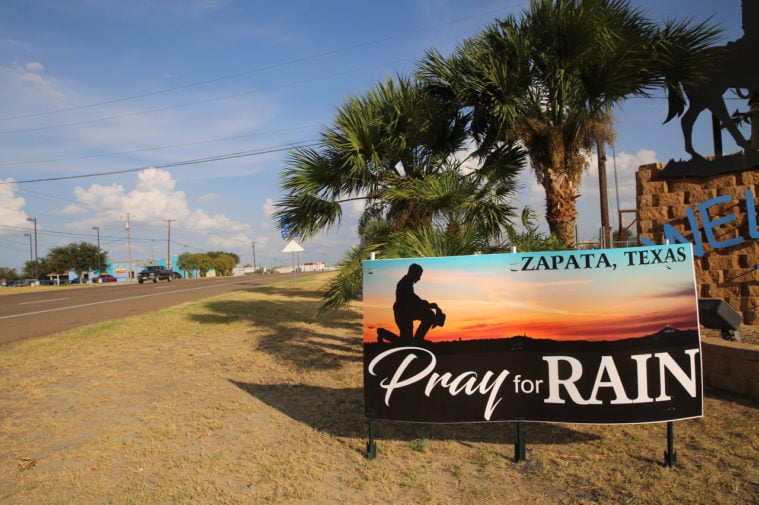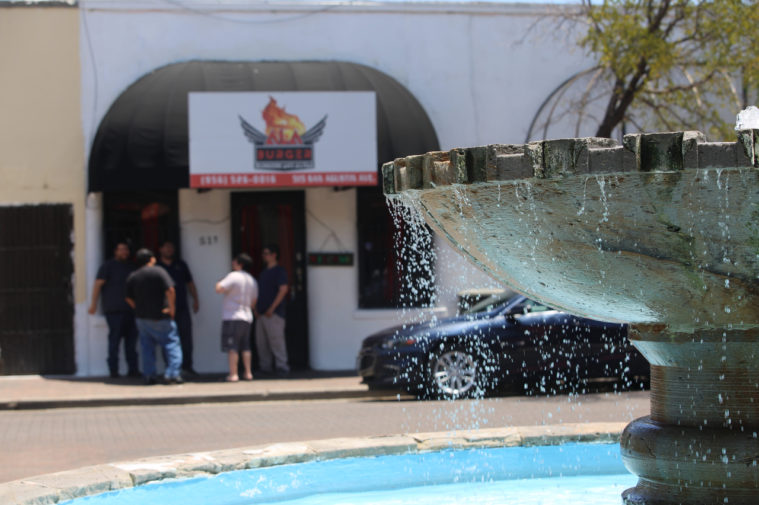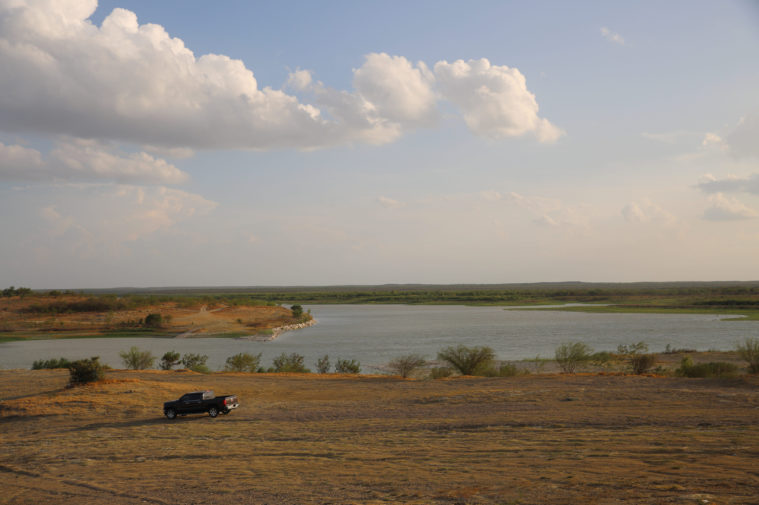This article originally appeared on Inside Climate News, a nonprofit, independent news organization that covers climate, energy and the environment. It is republished with permission. Sign up for their newsletter here.
A mounting water supply crisis in scorching far South Texas has left local governments pressed to respond. Two major cities, Brownsville and McAllen, rolled out watering restrictions in recent weeks and their counties made disaster declarations, seeking emergency state funds. The reservoirs that support the region are lower than they’ve ever been.
When city council members met Monday in Laredo, an 18th century Spanish frontier town and the largest South Texas city on the Rio Grande, it was their turn to craft a response. What they came up with illustrates the region’s helplessness to meet a changing climate and its willingness to approach the brink of disaster for the sake of green grass.
In Laredo’s city hall, council members watched on a screen as Martin Castro, watershed science director for the nonprofit Rio Grande International Study Center, showed a graph of projected water supplies if severe drought persists—they could run out next spring.
“At that point we will be under very strict water rationing like other cities are in Mexico,” Castro told the council, urging the adoption of restrictions. “If we continue to wait, we’re getting to a point where it won’t make a difference.”

But faced with the crisis, all the city council could offer was a debate about how many days per week Laredoans should be allowed to water lawns. One day per week was too strict, they decided, so they settled on three, and only at night. It would be enforced by the water department’s code enforcement division—two people. Violators would get two warnings before a citation. Mostly, planners hoped for voluntary participation.
Some worried what restrictions would cost the city’s aging water supply system, which needs water sales to fund critical improvements.
“When we cut use we also cut money,” said councilman Dr. Marte Martinez. “We’ve got to look at both sides: the drought conditions, but also all the investments we have to make.”
And, he said, “we have plenty of water right now.” It was only the communities downstream in the Rio Grande Valley, and in neighboring city Zapata, as well as others across Northern Mexico, which were facing a supply crisis.
“We don’t have to look too far to see what’s happening in other communities that have waited to take conservation steps,” local attorney Carlos Flores told the council. “Asking someone to do something voluntarily is not really a conservation step.”
Private households account for 65 percent of Laredo’s water use—some 671 million gallons per month. More than half of that goes onto lawns and gardens, said Arturo Garcia, utilities director for the city of Laredo.
“Asking someone to do something voluntarily is not really a conservation step.”
“During this heat people are really watering their yards, it was just excessive,” Garcia said. “Some people water every day.”
The city sells water to about 270,000 people—a figure that has doubled since the 1990s. Long gone are Laredo’s famous days of vaqueros on the open range. Today its old western historic downtown sits dilapidated in its center while traffic clogs the freeways of the sprawling city beyond. Nearby, the Port of Laredo, the nation’s largest inland port, processes more than $250 billion in annual trade with Mexico on trucks and trains.
Around the city’s edge, working oil wells recall the fracking boom of the late 2000s that drew jobs and people to the Eagle Ford Shale that sits beneath Laredo. Even the border security agenda has brought wealth here through expanded Border Patrol headquarters, federally-funded immigrant detention centers and deployment of the Texas state guard.
Through all that time, Laredo drank freely from the Rio Grande and a giant reservoir, Amistad Lake, where it stores its water about 180 miles upstream, both of which are at extremely low levels.
Aged System Impedes Solutions
Decades of strong growth have left Laredo without a sophisticated municipal water system. The city has issued boil water notices four times in the past three years and some planners suspect it could happen again when Laredo imposes restrictions.
The system depends on users at every end to keep water moving. If water use drops, the system can stagnate. Already, the city’s utilities department flushes about a million gallons each day into city streets and storm drains just to keep fresh water in the system. It’s a standard practice for municipal water supplies, but Laredo is trapped in it more than most.
While the 30 million monthly gallons flushed barely compare with the hundreds of millions sprayed onto lawns, they still account for 3 percent of Laredo’s water use. It’s a situation that shows how poor investment in infrastructure can leave authorities unable to meet climate challenges.
“It’s a double-edged sword. When we want to start conserving water, we almost have to start flushing more,” said Michael Rodgers, assistant utilities director for Laredo.

Much of this situation traces back to a state-funded campaign in the 1990s to run city water out to impoverished, informal rural neighborhoods called colonias beyond the outskirts of the city.
“We oversized the lines hoping there would be lots of development that didn’t happen,” said Riazul Mia, assistant city manager of Laredo and former utilities director.
Now, fire hydrants in empty fields must constantly be backed by 1,000 feet per second of water in the pipes. Meanwhile users on the far end are low income and don’t use much water, forcing authorities to dump the contents of parts of the system every few days when the stagnant water gets too old.
There’s another problem: 30 percent of Laredo’s pipes are more than 40 years old.
“We have grown so fast we didn’t have the funding to replace the old pipes,” Mia said. “So now you have all these new subdivisions which are eventually connected to old pipes.”
In February, a major transmission line from 1971 broke, leaving half the city without water and triggering a citywide boil notice.
The aging system means that the available budget goes to fix old pipes, leaving nothing leftover for the big projects this city needs to meet the challenges of population growth and drought.
‘We Have to Stop Ignoring the Warning Signs’
Last year, Laredo’s 50-year water plan assessed that the city’s growth would exceed its water supply by 2040. It proposed a slate of expensive projects: pipelines running up to 150 miles to aquifers in nearby counties. (Laredo has no groundwater of its own.)
“We had this 2040 timeline in our heads, then with this year’s drought things just got out of control so quickly,” said Tannya Benavides, advocacy director with Commission Shift, an oil and gas watchdog in Laredo. “We have to stop ignoring the warning signs.”
Advocates agree, thrice weekly lawn watering will not be what carries Laredo into the future.
But as the city council met on Monday, the biggest rains of the year so far were falling in Laredo and along the Rio Grande, dulling the sense of urgency towards the crisis that had seemed to be spiraling just a few days before. Mayor Pete Saenz warned the council not to lose focus.

“There’s a tendency once we start getting some rains to move away from whatever plans we have,” he said. “We can’t give up.”
The city needed more water soon. All of its water budget was slated for system repairs. The federal infrastructure bill this year made money available for these sorts of city improvements. Mayor Saenz said that bill may be the best chance the city gets. Laredo’s representatives are working in Austin to seek state support for the emergency pipeline.
“We need help. We cannot do it alone locally. It would throw us into a horrendous financial bind as a community for us to try to attempt to bring in water,” Saenz told the council. “If somehow the state says no, we have no choice. We’d have to suspend basically everything that we have.”







